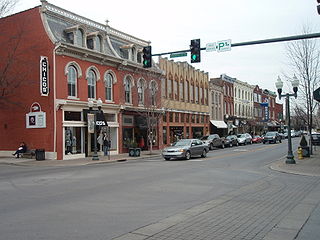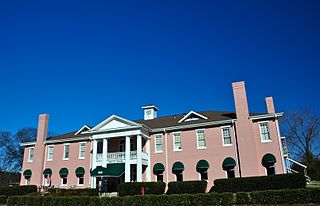
Sevierville is a city in and the county seat of Sevier County, Tennessee, United States, located in eastern Tennessee. The population was 17,889 at the 2020 United States Census.
Charles Andres House is a historic house on Middle Bass Island in Lake Erie, off the northern coast of Ohio. The house was built by winemaker Charles Andres, a German immigrant who moved to Middle Bass Island in 1854. Andres bought the 17-acre (6.9 ha) plot where he built his house in 1866, using most of the land for his vineyards. Ohio's Lake Erie islands, particularly the Bass Islands, were a major winemaking center in the nineteenth century, and most of its wineries were small operations run by German immigrants such as Andres. The two-story house has a vernacular design which incorporates elements of the Italianate and Greek Revival styles. Its design is typical of Bass Islands architecture of the era, as winemakers often put their profits toward large and attractive homes.
Smithson–McCall Farm is a 256.3-acre (103.7 ha) historic district in Bethesda, Tennessee. The farm was listed under the National Register of Historic Places in 2007. The listing claims that the property "documents the impact of the progressive agricultural movement of the early twentieth century on the operations and landscape of a middle-class family farm," and includes an "architecturally significant group of buildings and structures, placed within an agricultural landscape of high integrity...that represents a good example of farmstead architecture in Middle Tennessee and that reflects the impact of the Progressive Farm movement of the early twentieth century".
The Newton Cannon House is a property in College Grove, Tennessee, that was the home of Newton Cannon, a U.S. Congressman and Governor of Tennessee. The earliest section of the building was built circa 1800 as a log structure. The house was listed on the National Register of Historic Places. After the house was burned in an arson fire on January 27, 1987, it was removed from the National Register.

Franklin Historic District is a historic district in Franklin, Tennessee that was listed on the National Register of Historic Places in 1972. It was created to preserve historic commercial and residential architecture in a 16-block area of the original, downtown Franklin around the north, west, and south of the town square.

The Foster/Bell House is an historic building located in Ottumwa, Iowa, United States. The original house on the property was the home of Judge H.B. Hendershott built in 1862. He sold the property to Thomas D. Foster in early 1890s. He was the chairman and general manager of the meat packing firm John Morrell & Company from 1893 to 1915. Foster hired architect Ernest Koch to design the present residence. It was originally a frame and stone house in the Neoclassical style that was completed in 1893. The house passed to Foster's daughter Ellen Foster Bell who hired the Des Moines architectural firm of Kraetsch and Kraetsch. They redesigned the exterior to its present Tudor Revival style in 1923. The architectural firm of Tinsley, McBroom & Higgins made significant changes to the interior in 1929. It features Sioux Falls red granite on the main floor.

The Fifth Street Bluff Historic District is a nationally recognized historic district located in Ottumwa, Iowa, United States. It was listed on the National Register of Historic Places in 1998. At the time of its nomination it contained 67 resources, which included 40 contributing buildings, three contributing structures, and 24 non-contributing buildings.

Ashcrest Farm is a historic mansion in Hendersonville, Tennessee, United States. Designed in the Classical Revival architectural style, it was built by slaves before the American Civil War and black laborers after the war. The land has been owned by the same family since 1810. Today, it is a horse farm.

The Lairdland Farm House is a historic farmhouse in Giles County, Tennessee, U.S..

The Newton White House is a historic house in Pulaski, Tennessee. U.S..
The Wilson-Young House is a historic mansion in Dellrose, Tennessee, U.S.. It was built in 1850 for Andrew Madison Wilson. It was designed in the Federal architectural style. It has been listed on the National Register of Historic Places since April 13, 1973.

The Austin Hewitt Home is a historic mansion in Pulaski, Tennessee, United States. It was home to the Pulaski Female Academy from 1832 to 1852. It was the private residence of the Childers, Ragsdale and Beasley families until 1924, when it became a home for indigent homeless women endowed by philanthropist Austin Hewitt. It is now a retirement home.

The Alexander Ewing House is a historic mansion in Nashville, Tennessee, U.S. The two-story plantation home was built in 1821 in the Federal architecture style for Alexander Ewing. It is constructed of brick with a stone foundation and a gable roof. Both the north and south side elevations feature a pair of chimneys connected by a parapet wall. The house has been listed on the National Register of Historic Places since November 25, 1980.
The Thomas P. Kennedy Jr. House is a historic mansion in Forest Hills, Tennessee, U.S.. It was built in 1937 for Thomas P. Kennedy Jr., the president of O'Bryan Brothers Inc. It was designed by Donald W. Southgate in the Colonial Revival architectural style. It has been listed on the National Register of Historic Places since October 27, 2003.
The P. D. Houston Jr. House is a historic mansion in Forest Hills, Tennessee. Also known as Woods Cote, it was built in 1941 for P. D. Houston Jr., a banker who became the president of the First American National Bank in 1957. It was designed in the Tudor Revival architectural style by Warfield and Keeble. It was purchased by Norris H. Nielsen and his wife Britton in 1972. It has been listed on the National Register of Historic Places since October 27, 2003.
The Richard E. Martin House, also known as Castlewood, is a historic mansion in Forest Hills, Tennessee. It was built in 1931 for Richard E. Martin.

The Bass-Perry House is a historic plantation house in Seale, Alabama, U.S.
The Maple Dean Farm is a historic farmhouse in Shelbyville, Tennessee, U.S.. Built in 1886 on a farm established in 1819, it was designed in the Eastlake architectural style. It became a century farm in 1976, and it was listed on the National Register of Historic Places in 1976.
Donald W. Southgate (1887–1953) was an American architect. He designed many buildings in Davidson County, Tennessee, especially Nashville and Belle Meade, some of which are listed on the National Register of Historic Places.
The James Dickson House, also known as the Sparks House, is a historic house in Linden, Tennessee. It is an example of the "Middle Tennessee I-House," a regional variation on a vernacular architecture style of central passage house with a portico.











